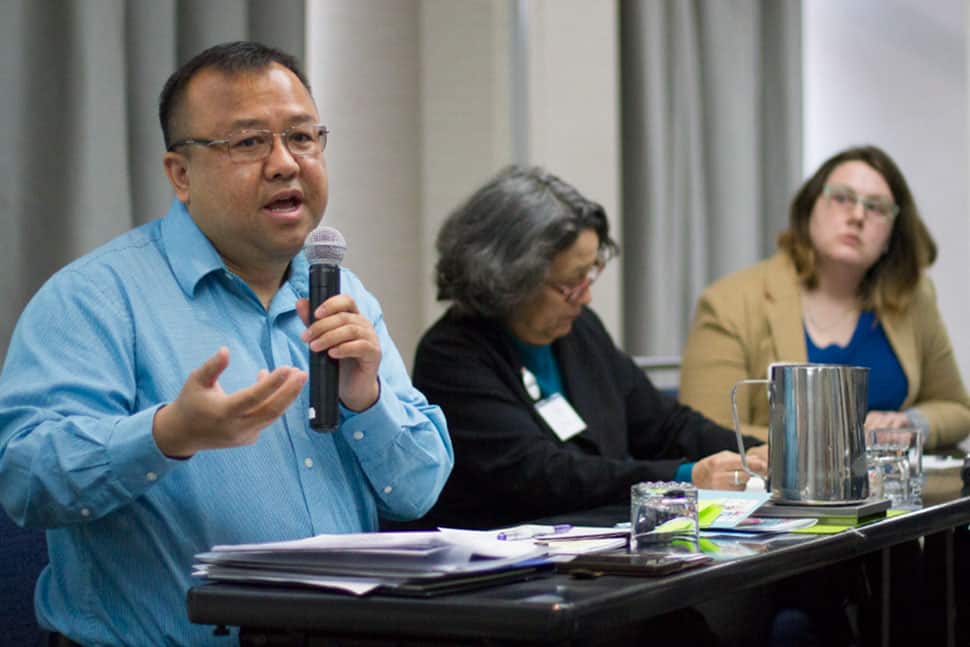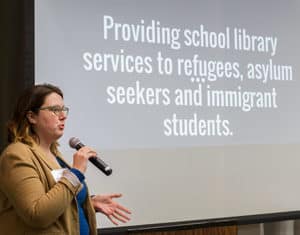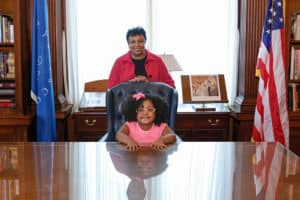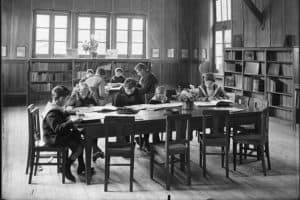
“The pipeline is reopened,” said Ngoan Le, state refugee coordinator at Illinois’s Bureau of Refugee and Immigrant Services. Le was speaking to attendees on February 6 at Project Welcome: Libraries Serving Refugees and Asylum Seekers, a daylong summit of presentations and group discussion organized by the Mortenson Center for International Library Programs at the University of Illinois at Urbana-Champaign in partnership with the American Library Association, in Chicago. Her words came just three days after US District Court Judge James Robart blocked President Donald Trump’s executive order travel ban preventing Syrian refugees and people from six other majority-Muslim countries from entering the US.
The refugee crisis isn’t new. According to the US State Department, more than 3.3 million refugees—persons fleeing their home country to escape persecution, war, or violence—have resettled in the US since 1975. But the summit seemed timely, as the legality as to who should be welcomed within US borders is tested, and debate among the public grows. “It’s very rare in the history of the US that we’d pick a particular country and say, ‘You can’t come in,’” said Le. She noted that those seeking resettlement may require extra care and sensitivity because of traumas they may have experienced.
That’s where libraries come in. Organized with funding from the Institute of Museum and Library Services, the summit is part of a grant program that aims to answer how libraries and other organizations can provide services to refugees and asylum seekers. Clara Chu, project coordinator and director of the Mortenson Center, asked attendees to consider six key areas as they listened to presentations: what is known about refugees and asylum seekers as users libraries are targeting, how libraries can be promoted among this population in the community, what types of partnerships libraries should be considering, what the role of different types of libraries should be in providing services to refugees and asylum seekers, what professional knowledge and skills are needed to administer services, and how to make libraries more welcoming.
At the culmination of the grant program, Chu says the center will issue a national report with recommendations and an action agenda.
US libraries and library organizations get involved
Half of all refugees are under 18 years old, the United Nations High Commissioner for Refugees (UNHCR) reported in 2015. MaryAnne Confer, a librarian at Farragut Career Academy in Chicago’s diverse Little Village neighborhood, encounters members of this population daily.
“We can provide a safe space for them,” says Confer, noting how the school library’s quiet atmosphere and internet access make it an ideal enclave for young refugees, immigrants, and asylum seekers.

School libraries should have physical and online materials in home languages when possible, Confer says, but acknowledges that finding books in other languages can be a challenge. Not only is it difficult to find materials that are age and culturally appropriate, they may be cost prohibitive to schools. Confer says this is one of the reasons why partnerships are important, such as the one Farragut has with Chicago Public Library.
She says not to neglect the simple things, such as pointing out your library when giving students a tour of the school for the first time. “Depending where these students are coming from, they might not have experience with public libraries or school libraries,” says Confer. Librarians and teachers should also be careful with voice levels, physical contact, or behavior that could potentially trigger students who have lived through disturbing events.
What’s the number one thing public school libraries can do to have the biggest impact? Confer thinks it is advocating for refugees, asylum seekers, and immigrants “when you’re meeting and planning with teachers,” and keeping in mind the needs of students who don’t speak English.
Touger Vang, one of the summit moderators and public services coordinator at Yolo County (Calif.) Public Library, commented on some of the things high schools and academic institutions can do to help students, both from his perspective as a practitioner and as a refugee from Laos who remembers the services aiding his resettlement years ago.
“Tailor your information literacy class to your students’ needs,” Vang says. “Every immigrant culture is different,” which is why he thinks it’s important to devote programming or dedicate communications efforts to reaching parents and conveying the importance of higher education.
Vang described initiatives that help refugees with practical skills, such as how to dress for work or excel on a job interview, and he provided tips for working with refugees who may already have professional degrees or careers in their home country, and how to fast-track their college education or employment in the US.
He also had a simple suggestion for school libraries: One day a week, keep the library open after classes to provide a safe social space that offers homework help. That, he says, was something that appealed to him significantly as a student.
Reforma, the National Association to Promote Library and Information Services to Latinos and the Spanish Speaking, has focused its attention on the US–Mexico border and administering services to the many children who are detained there. Oralia Garza de Cortés, cofounder of Reforma’s Children in Crisis project, says that 186,233 children under 18—mostly from El Salvador, Honduras, and Guatemala—have been detained since 2009, most of them voluntarily handing themselves over to US Border Patrol. She says that 91% are eventually deported.
As such, Reforma assembled an international delegation to visit the border to bring books to children who are awaiting hearings as a form of distraction and empowerment. “That’s what we felt was missing in their lives,” says Garza de Cortés.
The Children in Crisis project has made donations to the Brownsville (Tex.) Public Library, which hosted friendly visits with the children; collaborated on activities with librarians in Tijuana, Mexico; performed direct outreach at bus stations in Texas; and created a slew of resources, including a toolkit, reading list, and distributable English–Spanish pocket cards that can help kids apply for library cards.
These kids, says Garza de Cortés, “are not just on the border—they’re all across America, they’re waiting for their hearings, they’re in your communities.”
The summit’s poster session gave added insight as to what other school, public, and academic libraries in the US are doing to help refugees and asylum seekers. University of Maryland’s “Amira in America” project, presented by graduate assistants Andrea Castillo and Liz Laribee, showed how using a coloring book format may reach Syrian refugee children who are struggling with English or mental health issues. University of North Texas’s “Welcome Home, Superheroes!” project, presented by doctoral candidate Jenny Mumah, was similar in theme, showing how a weekly graphic novel program can teach skills and be therapeutic to refugees, citing Maus by Art Spiegelman and the Persepolis series by Marjane Satrapi as examples.
International libraries provide inspiration
More than 30 countries around the world currently accept refugees for resettlement, according to UNHRC. Germany is one of the most high profile of those countries, having received 745,545 asylum applications in 2016, mostly from majority-Muslim countries.
Anne Barckow, who works in the Department of Intercultural Services at Bücherhallen Hamburg (Hamburg Central Library), says libraries can assist with language and learning, Wi-Fi, foreign-language material, integration into the professional world, networking, or simply with programming such as exhibits and lectures. “We are close to where people live, which helps integrate them into the neighborhood,” says Barckow.
She also notes the many challenges to providing quality services, such as time, cost, language barriers, illiteracy, bureaucracy, acceptance, and social injustice. Barckow says that some community members sometimes feel resentment toward refugees and think they get special treatment, such as qualifying for discounted library cards. Given the many obstacles, Barckow is an advocate of partnerships—her library is supported by Deutscher Bibliotheksverband (German Library Association) and Goethe-Institut—and she credits Hamburg Library’s 466 volunteers for making refugee projects possible.
Depending where these students are coming from, they might not have experience with public libraries or school libraries.—MaryAnne Confer, school librarian at Farragut Career Academy in Chicago
There is “little institutional resentment” toward refugees in Toronto, says Suleka Sathi, library service manager at the Agincourt branch of the Toronto Public Library. Opposition may be harbored by some individuals, but because Toronto is one of the most multicultural cities in the world (51% of the city’s population was born outside of Canada, and one in 12 people arrived within the previous five years), she says people prefer to “pay it forward” and approach the refugee crisis with empathy and compassion.
Libraries have a role in offering “a welcome that is respectful and responsive to their needs,” says Sathi, and in doing so, “language precedes action.” She thinks the first step to eliminating barriers is connecting patrons to someone who speaks their language, and Toronto Public Library’s Language Line service does that. “We don’t want to be the ones putting up the barriers to delivering services,” she says.
Toronto is administering to an incoming Syrian population, as Canada has accepted 40,081 Syrian refugees as of January 29. Sathi described hotel outreach visits to Syrian families while they were waiting to be resettled, events with Arabic-speaking staff, and the Museum and Arts Pass that is provided for Syrian families, which gives them access to cultural attractions free of charge. Sathi thinks organizations should focus “not only the settlement issues—food, housing, work, getting kids registered for school—but to minimize social isolation” as well.
But what about the connection we can give refugees to their pasts? Switching gears, Trishanjit Kaur, library and information science professor at Punjabi University, explained the 1947 Partition Archive, which seeks to preserve the memories and history of a darker time in India, when the subcontinent was being divided along sectarian lines following independence from British rule. An estimated 14 million Muslims, Hindus, and Sikhs were displaced in the world’s largest known population migration, and there was much devastation and suffering—especially for women, Kaur says, who were abducted, separated from their families, or subjected to “honor killings.”
Because the pain remains, an archive was born in 2011. “Libraries can play a significant role in preserving the memories of refugees,” Kaur says. She also notes that the invaluable information and resources harnessed by libraries can aid in locating and reunifying families.
Government agencies and support organizations dash misconceptions
“Resettlement is a very small part of what we do,” says Anne-Marie McGranaghan, associate resettlement officer at UNHCR. Her organization offers physical and legal protections to people overseas and “tries to decide who is most vulnerable” based on categories (such as survivors of violence and torture, family reunification, urgent medical needs, urgent protection problems, women and girls at risk) and groups, which are similarly situated populations.

McGranaghan is quick to dispel the belief that refugees apply for a new country. “Refugees don’t really apply,” she says, but are submitted for a resettlement country after a series of interviews and are placed by organizations, often living in camps and waiting without legal status or traveling privileges.
“Refugees have fled because they have to, not because they want to,” adds Le. “Resettlement is really the … last option.”
Le described the roles of the State Department, related federal offices, social services offices, and local partners in screening and admissions, reception and placement, and covering basic needs. At Illinois’s Bureau of Refugee and Immigrant Services, Le says the organization’s first priority is to find refugees a job—and refugees are required to take the first job available.
Kate Steger of the International Rescue Committee (IRC), an organization that last year resettled 13,000 refugees, talked about the Cultural Orientation Resource Exchange (CORE) program for which she is deputy director. People may be unaware that cultural orientation is a service that resettlement agencies are required to offer, says Steger, and refugees have the opportunity to attend prearrival and postarrival programs. Some topics covered in cultural orientation classes include international travel, employment, education, health care, community services and public assistance, US laws, budgeting and finance, local transportation, and cultural adjustment. Among CORE’s goals are to help refugees thrive, empower citizens, and integrate communities.
People may also not understand the tragedies that refugees have faced, or the depth of emotions they’re dealing with. Melineh Kano, a refugee from Iran and executive director of RefugeeOne, which has welcomed more than 16,000 refugees to the Chicago area, says her organization added mental health services to their offerings five years ago to meet a need. “A lot [of refugees] come from trauma and have post-traumatic stress disorder,” Kano says. “We have to address the needs of the entire family.”
Opportunities for participation and growth
“Refugees and immigrants are not aware of the services offered by public libraries outside of books and computers,” says Aklilu Adeye, executive director of the Ethiopian Community Association of Chicago.
Many presenters from government agencies and support organizations remarked on how the library is ideally situated and equipped to make a difference in the lives of refugees, immigrants, and asylum seekers, but there are still opportunities to do more—and market better.
“Combining library services and childcare would be really great,” says Steger, who noted that many women have missed cultural orientation classes because they had to watch their kids.
RefugeeOne has begun to leverage the power of libraries. “We love libraries. We use libraries. Thank you for creating a safe haven,” says Kano. “We partner with libraries, especially for youth programs.”
Perhaps equally encouraging is that government agencies and support organizations can be inspired to partner with or promote libraries, too.
“We can add on our own internal requirements,” says Sandra Vines, director for resettlement at IRC. Vines sounded excited about one potential requirement that she thinks would be easy to factor into the resettlement process: “Library cards!”
Updated Feb. 21, 2017, to correct details regarding Kate Steger’s role and cultural orientation. Updated Feb. 23, 2017, to include Andrea Castillo as a presenter of “Amira in America.”


